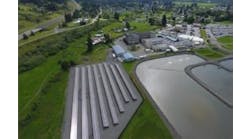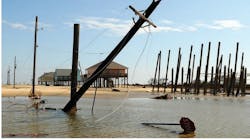Many factors make microgrids unique, including their ability to island in the case of a power outage. And alternative models like energy-as-a-service are making these microgrids more accessible. This final entry from a new special report series shares details of real microgrid projects from AlphaStruxure, a joint venture of The Carlyle Group and Schneider Electric.
Download the full report.
To be successful, an energy-as-a service microgrid requires a developer and operator with extensive financial and engineering capabilities. So the first step for your business or organization is to find an able partner.
It’s best to seek a company that offers capital/structuring and design, build, own, operate and maintenance capabilities. Your partner should also have expertise in energy efficiency, power purchase agreements, managing and optimizing a microgrid digital platform and collecting and analyzing the platform’s data. The partner must be more than a consultant; you’ll need a developer/operator who takes on risk and guarantees performance of the microgrid, likely to be two or more decades.
Because energy-as-a-service microgrid development requires multiple levels of expertise, joint ventures are forming between major energy technology companies and capital providers to accomplish the task.
One example is AlphaStruxure, a joint venture of The Carlyle Group and Schneider Electric. The Carlyle Group, one of the world’s largest investment firms, manages over $220 billion in assets with 33 offices across 19 countries. Schneider Electric, a global energy management and automation company, and an early leader in microgrids, is credited with installation of 300 microgrids and related control equipment in North America alone. AlphaStruxure’s energy-as-a-service offer is backed by the staying power and credibility of two industry leaders in energy and finance.
Next we profile two microgrid projects that demonstrate Schneider Electric and AlphaStruxure’s track record and capabilities.
The Montgomery County, Maryland Microgrids
After a derecho caused massive power outages in Montgomery County, Maryland, government officials began exploring resilience for essential facilities. Out of their efforts came two industry-leading microgrids: one for the county’s public safety headquarters in Gaithersburg and another at a correctional facility in Boyds.
Schneider Electric has partnered to develop a microgrid at a public safety facility in Montgomery County, Maryland. (Photo: Schneider Electric)
Developed by Schneider Electric and a financial partner, the microgrids serve as a model for effective public/private partnerships that use the energy-as-a-service model. Montgomery County gained the reliability, economic and environmental benefits of a microgrid at a locked-in rate without making a capital outlay. In addition to gaining long-term price certainty, the county facilities retain electric power when the central grid goes down.
The project had another bonus for the county. They incorporated into the 25-year agreement the costs of electrical infrastructure upgrades that the county needed to make to its 50-year-old public safety headquarters. The county was able to pay for the upgrades from energy savings the microgrid generates.
“Our partnership with Schneider has enabled us to do over $5 million in capital improvements—major electrical switchgear and things like—because of the savings generated from energy reductions. Five million in capital improvements is significant,” said David Dise, director of the county’s department of general services, in a Facebook interview with Kevin Self, Schneider’s vice president strategy, business development & government relations.
Because of their ability to island, microgrids offer a way for ports to secure electricity supply even if a power outage occurs on the central grid. Reliable electricity is crucial to major ports given the volume of business they do.
Fast facts: Montgomery County microgrids
- Produce 11 million kWh/year
- Reduce greenhouse gas emissions by 5,900 metric tons annually, the equivalent of taking more than 1,200 cars off the road
- Two megawatts of solar photovoltaic canopies mounted over the existing parking lot
- An 800 KW combined heat and power (CHP) system
- Electric vehicle charging stations and a cyber security system
- Receives state clean energy credits and benefits from the state’s aggregate net energy metering policy
- First facility of its kind to achieve Platinum certification from the Green Business Certification Inc.’s (GBCI) PEER rating system recognizing sustainable infrastructure.
Port of Long Beach Microgrid and Electrification
The second busiest container port in the United States, the 3,200-acre Port of Long Beach handles $194 billion in cargo per year. It has 140 shipping lines with connections to 217 seaports.
Known as ‘The Green Port,” it is living up to its name with microgrid and electrification projects.
The Port is home to a $5.2 million microgrid development commissioned with Schneider Electric.
“Ensuring a stable supply of energy is crucial to the zero-emissions future the Harbor Commission envisions for the Port of Long Beach,” said Tracy Egoscue, president of the Long Beach Board of Harbor Commissioners.
Port of Long Beach (Photo: Sergey Novikov/Shutterstock.com)
Because of their ability to island, microgrids offer a way for ports to secure electricity supply even if a power outage occurs on the central grid. Reliable electricity is crucial to major ports given the volume of business they do.
The microgrid bolsters energy resilience for the port’s critical response facility, the Joint Command and Control Center (JCCC), which functions as its security hub.
“Across all industries and public entities, there is increasing demand to bolster energy resilience to support business continuity at critical facilities. The plans of the Port of Long Beach illustrate the foresight required to augment ongoing electrification efforts with resilience,” said Mark Feasel, vice president, smart grid and microgrid, Schneider Electric.
As part of the project, Schneider helps compile and analyze 12 months of performance data to ensure the microgrid moves the port towards its energy resilience goals.
The project integrates distributed energy resources and microgrid controls, including:
- A 300-kW solar array
- 250-kW microgrid-extending mobile battery energy
- A 500-kW diesel generator
- Schneider’s pre-configured hardware solution, Energy Control Center DC coupled and merged with technologies from partner EnSync Energy, mobile storage solution and microgrid controls. Energy Control Center will also leverage 330 kW/670 kWh of stationary battery energy storage
- Schneider’s EcoStruxure Microgrid Advisor, the cloud-connected, demand-side energy management software platform that simplifies the port’s DER integration and allows microgrid operators to collect, forecast and automatically optimize operations
- Schneider’s EcoStruxure Power solutions including Power Monitoring and Power SCADA Operation.
- Additional microgrid controls to allow demand response, peak shaving, and microgrid islanding
The port will serve as a site for federal, state, and local response agencies to visit and learn about microgrids. Schneider Electric is developing a “lessons learned” guidebook about the project to support replicability and commercialization of microgrids—part of the goal of the CEC grant program. As part of the project, Schneider also will undertake local workforce development with Long Beach City College and the International Brotherhood of Electrical Workers.
This is the last entry in a special report series explaining the relationship and potential of energy-as-a-service and microgrids. See prior entries below:
-
Are Energy-as-a-Service Microgrids the Next Logical Step for California…and the Rest of the U.S.?
- Why Microgrids are the Next Logical Step in the Evolution of Energy Management for Businesses
We also invite you to download, “Why Energy-as-a-Service Microgrids are the Logical Next Step for California…and the Rest of the U.S,” free of charge, courtesy of AlphaStruxure. And we encourage you to share this link widely to help educate California — and the rest of the U.S. — about energy-as-a-service microgrids.







